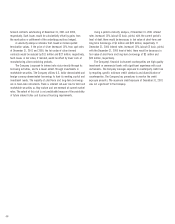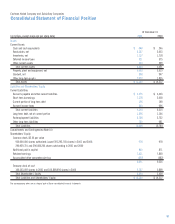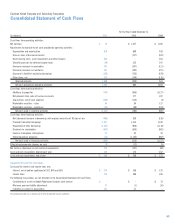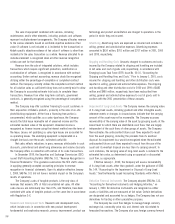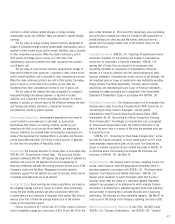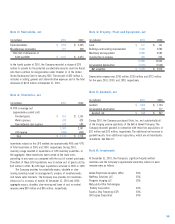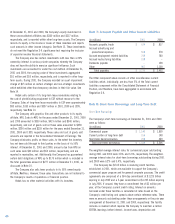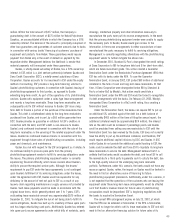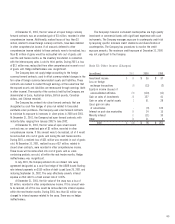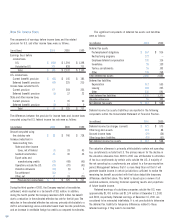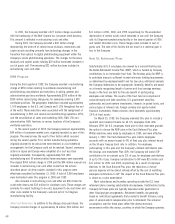Kodak 2001 Annual Report Download - page 60
Download and view the complete annual report
Please find page 60 of the 2001 Kodak annual report below. You can navigate through the pages in the report by either clicking on the pages listed below, or by using the keyword search tool below to find specific information within the annual report.
58
and Other Intangible Assets,” collectively referred to as the “Standards,”
which are effective for the Company as of January 1, 2002, except as
noted below. SFAS No. 141 supercedes APB No. 16, “Business
Combinations.” The provisions of SFAS No. 141 (1) require that the
purchase method of accounting be used for all business combinations
initiated after June 30, 2001, (2) provide specific criteria for the initial
recognition and measurement of intangible assets apart from goodwill,
and (3) require that unamortized negative goodwill be written off
immediately as an extraordinary gain instead of being deferred and
amortized. SFAS No. 141 also requires that, upon adoption of SFAS No.
142, the Company reclassify the carrying amounts of certain intangible
assets into or out of goodwill, based on certain criteria. SFAS No. 142
supercedes APB No. 17, “Intangible Assets,” and is effective for fiscal
years beginning after December 15, 2001. SFAS No. 142 primarily
addresses the accounting for goodwill and intangible assets subsequent
to their initial recognition. The provisions of SFAS No. 142 (1) prohibit the
amortization of goodwill and indefinite-lived intangible assets, (2)
require that goodwill and indefinite-lived intangible assets be tested
annually for impairment (and in interim periods if certain events occur
indicating that the carrying value of goodwill and/or indefinite-lived
intangible assets may be impaired), (3) require that reporting units be
identified for the purpose of assessing potential future impairments of
goodwill, and (4) remove the forty-year limitation on the amortization
period of intangible assets that have finite lives.
The Company will adopt the provisions of SFAS No. 142 in its first
quarter ended March 31, 2002. The Company is in the process of
preparing for its adoption of SFAS No. 142 and is making the
determinations as to its reporting units and the amounts of goodwill,
intangible assets, other assets, and liabilities allocated to those
reporting units. The Company is evaluating the useful lives assigned to
its intangible assets and does not anticipate any material changes to
such useful lives.
SFAS No. 142 requires that goodwill be tested annually for
impairment using a two-step process. The first step of the goodwill
impairment test is to test for a potential impairment. The second step of
the goodwill impairment test is to measure the amount of the impairment
loss. The Company expects to complete steps one and two of the goodwill
impairment test during the first quarter of 2002. The Company does not
believe that the results of these impairment test steps will have a
material impact on the Company’s consolidated financial statements.
In August 2001, the FASB issued SFAS No. 144, “Accounting for the
Impairment or Disposal of Long-Lived Assets.” SFAS No. 144 addresses
financial accounting and reporting for the impairment or disposal of
long-lived assets to be held and used, to be disposed of other than by
sale and to be disposed of by sale. Although the Statement retains
certain of the provisions of SFAS No. 121, “Accounting for the Impairment
of Long-Lived Assets and for Long-Lived Assets to Be Disposed Of,” it
supercedes SFAS No. 121 and APB Opinion No. 30, “Reporting the Results
of Operations—Reporting the Effects of Disposal of a Segment of a
Business, and Extraordinary, Unusual and Infrequently Occurring Events
and Transactions,” for the disposal of a segment of a business. SFAS No.
144 also amends Accounting Research Bulletin (ARB) No. 51,
“Consolidated Financial Statements,” to eliminate the exception to
consolidation for a subsidiary for which control is likely to be temporary.
The Statement is effective for financial statements issued for fiscal years
beginning after December 15, 2001 and interim periods within those
fiscal years, and will thus be adopted by the Company, as required, on
January 1, 2002. The adoption of SFAS No. 144 is not expected to have a
material impact on the Company’s consolidated financial statements.
The EITF has issued EITF Issue No. 01-09, “Accounting for
Consideration Given by a Vendor to a Customer (Including a Reseller of
the Vendor’s Products).” The EITF provides guidance with respect to the
statement of earnings classification of and the accounting for
recognition and measurement of consideration given by a vendor to a
customer, which includes sales incentive offers labeled as discounts,
coupons, rebates and free products or services as well as arrangements
labeled as slotting fees, cooperative advertising and buydowns. The
guidance with respect to the appropriate statement of earnings
classification of the consideration given by a vendor to a customer is
effective for annual and interim periods beginning after December 15,
2001. Upon adoption, financial statements for prior periods presented for
comparative purposes should be reclassified to comply with the
requirements under the EITF.
The guidance with respect to the accounting for recognition and
measurement of consideration given by a vendor to a customer is
effective for annual and interim periods beginning after December 15,
2001. The impact on the statement of earnings resulting from the
adoption of the EITF should be reported as a cumulative effect of a
change in accounting principle or applied prospectively to new sales
incentives offered on or after the effective date. The impact of the
guidance under EITF 01-09 on the Company’s consolidated financial
statements has not yet been determined.
Reclassifications Certain reclassifications of prior financial information
and related footnote amounts have been made to conform with the
2001 presentation.


